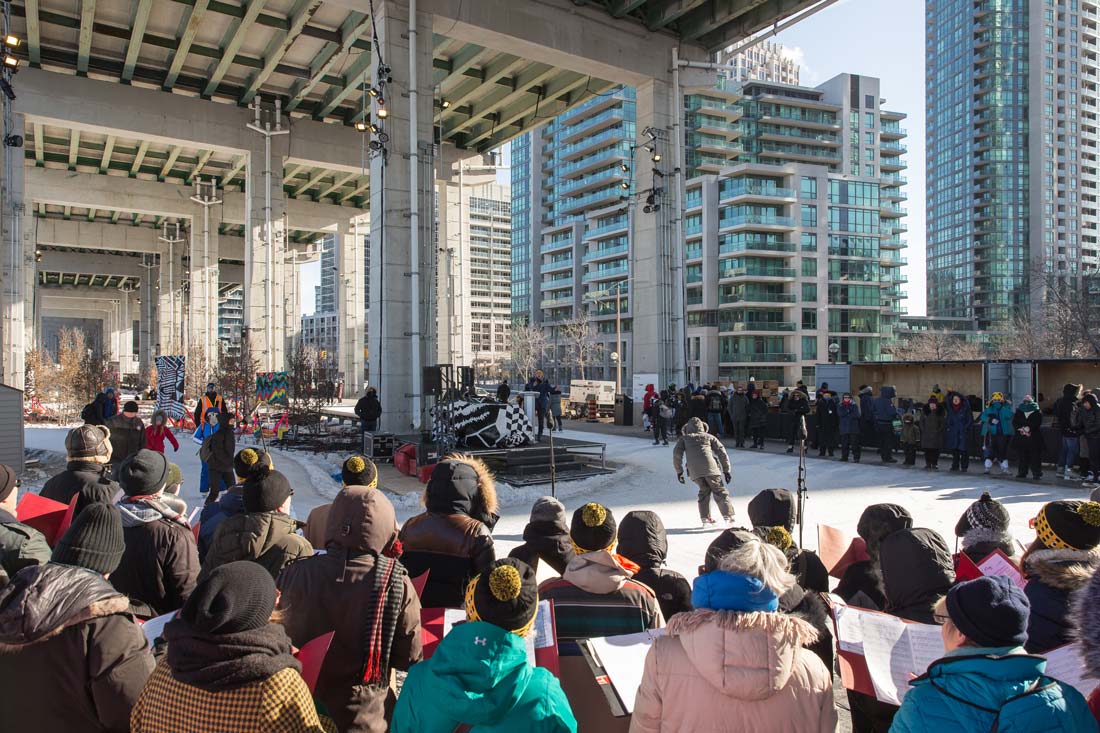The Bentway is transforming a 1.75km space under Toronto’s Gardiner Expressway into a vibrant public place where visitors can experience a diverse mix of activities and programs. The initial phase – from Strachan Avenue to Bathurst Street – reinvigorates the area beneath the expressway into a vital artery for pedestrians and cyclists, stitching together seven neighbourhoods, expanding access to key areas such as the Fort York National Historic Site, and creating a new gathering place for Toronto’s growing population. The multifunctional space is an expression of Toronto’s unique creative energy and serves as an example of how the re-use of infrastructure can support new forms of public life.
The project is unprecedented in many ways. It was funded through a unique public-private partnership between the City of Toronto and philanthropists Judy and Wilmot Matthews, who contributed $25-million to the project. Judy and Wil were inspired by the vision of urbanist Ken Greenberg and landscape architecture firm PUBLIC WORK to re-imagine the expressway – arguably the city’s most divisive symbol of 20th century transportation planning – as a new model of shared public space activated by year-round programming. The Bentway’s design and programming are rooted in its site – in its built environment and the layered histories and potential futures of the area. What happens at The Bentway “can only happen here.” Extensive public consultation with neighbours and an array of potential user groups informed both PUBLIC WORK’s design of the physical environment as well as the programming, which is now being brought to life by The Bentway Conservancy, a new not-for-profit that manages, operates and programs the space.
 Site Plan – Aerial
Site Plan – Aerial Site Plan – Phase 1
Site Plan – Phase 1 Site Plan
Site Plan
PUBLIC WORK’s starting point for the design was the Gardiner’s series of supportive concrete columns called “bents,” that can either function together or on their own to offer spaces for a diverse range of programming and events – from passive, contemplative spaces to creative hubs and marketplaces. The expressway provides a canopy at varying heights from intimate to a majestic 15-metres high, with the bents offering structural support for clamps, cables, power and lighting – which are designed to meet both the requirements of large performance groups and the needs of fringe productions. On the ground, the project knits together public and private land, treats storm water and repurposes displaced soil to establish a new topography.
Visitors descend into The Bentway at Strachan Gate via an open-air amphitheatre complete with washrooms and a green room, and bleachers to seat about 250. They can enjoy performances there or on an adjacent lawn that can accommodate another 500 people. A cedar “wharf” in front of the Fort York Visitor Centre offers another event space, adjacent to a “liquid landscape” of indigenous grasses that will be watered by storm run-off from the roadway above through a sustainable and thoughtful drainage system. The 220-metre skate trail that opened in January 2018 becomes a path with a kids’ splash pad in the summer. In the next phase, a wooden bridge suspended from the underside of the Gardiner will provide a warm and organic contrast to the industrial aesthetic and a safe route across Fort York Boulevard. From the bridge visitors will be able to look down onto Fort York, thereby broadening both the accessibility and awareness of the historic site. The novel design of the bridge, constructed from cross-laminated timber and glulam, harnesses the excess structural capacity of the existing concrete bents of the Gardiner to suspend the bridge from the existing structure.
The project’s materiality demonstrates resourcefulness and an overall desire to apply the lightest touch to achieve the greatest impact. For example, the paving system focuses on recycled materials including construction debris retrieved from the Leslie Street Spit. The numbers on the concrete columns, originally marked for repair purposes, are reinterpreted for wayfinding, cast into the path and painted on the bents with reflective paint that catches the daylight. Each material is reflective of the spirit of place and conveys the rich layers of Toronto’s history. PUBLIC WORK’s design of The Bentway creates a foundation of sustainable practices that anticipate its future use and evolution as a public space.



















